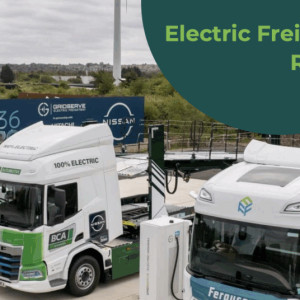eHGVs delivering lower total cost of ownership, latest Electric Freightway report reveals


The report has been produced by Hitachi ZeroCarbon and GRIDSERVE as part of the Zero Emission HGV and Infrastructure Demonstrator programme (ZEHID). The GBP100m Electric Freightway project, which brings together 30 partners, aims to lay the foundations for the biggest and most advanced electric HGV charging network in the world. It will run until 2030 with a fleet of eHGVs on the roads supported by a new network of charging infrastructure at motorway service areas and commercial depot charging stations.
In its latest report the consortium reveals an update on the roll out of eHGVs and the charging infrastructure. It highlights key developments for those participating in the project, including an unprecedented demand for eHGVs from consortium partners, with 79 electric trucks already delivered to fleet operators and another 78 on order - well beyond the original target of 140 vehicles. The report also reveals heightened industry interest and engagement with the project, with more than 20 organisations now benefitting directly from subsidised eHGVs through Electric Freightway.
This includes Amazon, Royal Mail, GXO and Wincanton, spanning sectors from retail and manufacturing to logistics and utilities. In addition, the first high-speed depot charging facilities have now been completed, including the landmark 10-bay shared Charge Yard at Nissan's Sunderland factory - one of the largest dedicated eHGV charging hubs in the UK. Meanwhile construction of public eHGV charging sites, which are crucial to enable long-haul journeys, is already underway at several key locations, with the first public hubs set to open later this year.
Analysis in the report also shows that under certain operational conditions, recognising each fleet is different, managers can reach cost parity with diesel vehicles after five years - with higher mileage operations standing to benefit more, lowering the overall total cost of ownership. Similarly, it reveals that the lifetime emissions of diesel trucks can be three times higher than eHGVs, and initial higher embedded emissions are usually offset within the first year. However the report notes that public EV charging provision remains capital intensive and extremely complex.
The report states: "Infrastructure bottlenecks remain, including lack of power provision, convoluted and inconsistent local planning regulations and space constraints." The consortium said: "Today's report marks a pivotal moment in the UK's journey to decarbonise freight, providing new insights into vehicle performance, charging infrastructure, and industry readiness. "While it shows that energy constraints continue to be a barrier to electrifying charging sites, the project has strengthened the TCO and environmental arguments for creating a viable eHGV network.
Keir Mather MP, Minister for aviation, maritime, and decarbonisation, said: "To create a cleaner planet and a stronger economy it's essential the lorries and vans' delivering goods across our country are supported to make the move to zero emissions. "That's why we've invested GBP200m to put more zero emission lorries onto our roads and build the charging network that keeps them moving. As this report shows the rollout is well underway and the future of freight is green."
Sam Clarke, GRIDSERVE head of eHGV, commented: "Delivering the 10-bay shared charging depot at Nissan's Sunderland plant is just the beginning of what a nationwide eHGV charging network can look like. "As the number of miles undertaken by electric fleets continues to grow, our priority is ensuring the infrastructure keeps pace, with the first public charging sites now under construction and many more to follow. "This report demonstrates how a national eHGV charging network is beginning to take shape, but it's only made possible by the industry working through the challenges together, and always with the needs of fleet managers front of mind."
Alongside today's report, Hitachi ZeroCarbon is unveiling a new TCO calculator designed to help fleet operators assess the financial and environmental case for electric HGVs. The interactive tool allows users to input their own operational data and instantly receive an estimate of total cost of ownership and the total CO2e from their specified fleet. By making these insights publicly accessible, the calculator aims to remove uncertainty, support investment decisions, and give industry stakeholders confidence in the economics of zero-emission road freight.
Leon Clarke, Hitachi ZeroCarbon head of operations and delivery, said: "Crossing half a million electric miles is a clear signal that eHGVs are not just viable, but already delivering in the real world. "What really matters now is giving managers the tools and evidence they need to make the transition with confidence. That's why we've launched our new total cost of ownership calculator, so fleets can build the business case for decarbonisation and bring their long-term operational goals closer into view.
"We're helping the industry move the EV debate onwards from theory to reality, and in turn strengthen the UK's position as a leader in developing the future of commercial transport."